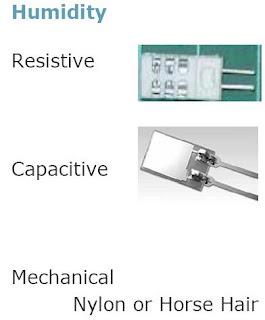Sensor in HVAC Hierarchy
Sensor Sales by €Sales and %
Road Show Sensor
Temperature Technologies
Energy Saving from Temperature Control
Heating:
Each one Degree reduction in set value is equal to a financial reduction of approximately €500 / month for each 1000m2 of floor space.
Cooling:
Each one Degree increase in set value is equal to a financial reduction of approximately €800 / month for each 1000m2 of floor space.
Or each 1 Degree C = 10% of total energy cost.
Ref: BRE (UK)
Humidity Energy Savings
No direct energy savings, but….
Achieved by combining with temperature to measure enthalpy
Enthalpy = Total Heat Content controlled to provide ‘Free Cooling’
Te = T + L/cp * w/(1-q) Joules
WhereTe = Heat Content
T = Measured Temperature
L = Latent Heat of vaporisation
Cp = Specific Heat of Dry Air –Constant pressure
q = Humidity
Air Quality –VOC Sensors
VOCs (Volatile Organic Compounds)Made from a metal oxide (SnO2) wrapped around a ceramic heater.When heated, oxygen is absorbed on the surface. Donor electrons are transferred to the absorbed oxygen creating a positive charge in a space charge layer. Surface potential is formed serving as a potential barrier against electron flow. i.e. we have variable resistance proportional to VOCs.This device reacts to a wide variety of gasses, some are desirable for energy saving, others are not.
Air Quality CO2 Sensors
CO2
IR absorption of radiation: non-dispersive infrared (NDIR) technique.
Molecules absorb light (electromagnetic energy) at spectral regions where the radiated wavelength coincides with internal molecular energy levels. By detecting the amount of light absorbed, within a narrow bandwidth that coincides with the resonance wavelength of the species selected, the number of molecules that are free from interference of other species can be measured.
CO2 Energy Saving
Fresh air supply can be adjusted proportional to the CO2 level, which in turn is proportional to the human activity within a space.
In times of low or no occupancy, full re-circulated air can be used saving over 20% of the energy consumption.
Most energy saving is from main plant installations. Individual room control is more for comfort conditions.
EUBAC Certification
Purpose: To apply performance criteria to HVAC devices and ensure that they meet minimum energy and accuracy targets.3rdParty testing of all systems and components, including valves, actuators and sensors.Test houses MUST be independent and be certified to ISO 17021 (Testing Accreditation), and have invested in proper HVAC test equipment.Certificates available on http://www.eubac.org/







Tidak ada komentar:
Posting Komentar